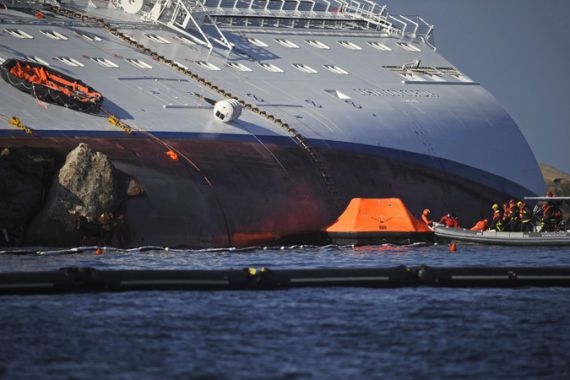Italy shipwreck captain ‘not wearing glasses’
New accusations leveled against captain who has already been held up to condemnation and ridicule around the world.

The captain of the wrecked Costa Concordia cruise liner was not wearing his glasses on the evening of the accident, the officer’s lawyer has said.
“That evening Schettino had left his reading glasses in the cabin and repeatedly asked [Ciro] Ambrosio to look at the radar to check the route,” Ambrosio’s lawyer Salvatore Catalano told Reuters outside a pre-trial hearing on the accident on Saturday.
Keep reading
list of 4 itemsDoes Israel’s Netanyahu have a plan for a ‘day after’ the war on Gaza?
Why Egypt backed South Africa’s genocide case against Israel in the ICJ
US sanctions two RSF commanders as fighting escalates in Sudan’s Darfur
The cruise liner capsized off the Tuscan island of Giglio after hitting a rock on January 13, killing at least 25 people and leaving seven people still unaccounted for.
Prosecutors have accused Captain Francesco Schettino of causing the disaster by bringing the Costa Concordia, carrying more than 4,200 passengers and crew, too close to the shore.
The first officer, Ciro Ambrosio, and seven other officers and executives of the ship’s owner, Costa Cruises, are also under investigation.
Backdoor entrance
Ambrosio had made the allegation about Schettino, 51, to investigating magistrates at previous hearings, Catalano added.
Schettino has said that the rock hit by the cruise liner was not on his navigational charts and acknowledged that he brought the ship too close to the shore, but he says he was not the only one to blame for the tragedy.
Catalano said Ambrosio ordered the evacuation of the listing vessel before the captain had made up his mind to do it.
None of those under investigation attended the closed-door hearing in the Tuscan city of Grosseto, which was held in a theatre to accommodate hundreds of victims’ relatives, survivors and lawyers for all sides.
Lawyers for Schettino, who is accused of manslaughter, causing a shipwreck and abandoning ship, slipped into the theatre through a backdoor.
Publicity stunt
Schettino denies wrongdoing and was not in attendance, but remains under house arrest in his home near Naples.
Findings revealed at the hearing will be used to help a judge determine if a trial is warranted.
With 4,200 passengers and crew aboard, the Concordia rammed into a reef near the island of Giglio during dinner hour on the Mediterranean cruise in January.
The ship quickly took on water after a rocky reef gashed a hole in the side of its hull, then capsized near Giglio’s port.
Prosecutors say the captain steered the ship too close to the island to show off the vessel to islanders in a publicity stunt.
Schettino has claimed that the reef, which appears on many tourist maps, was not on his navigational charts.
Civil lawsuit
Italian law allows injured parties to attach civil lawsuits to criminal cases, and they or their lawyers are permitted to attend hearings closed to the general public and media.
Among those entering the theater was survivor Sergio Ammarota, who said he was curious to see what would be learned when the so-called “black box” data recorder is opened and analysed.
Ammarota said he wanted to know “exactly how it [the crash] happened and why the captain … could have carried out such a maneuver”.
Some of the passengers and crew jumped into the water and swam to shore after the Concordia‘s tilt made it impossible to lower all the life boats.